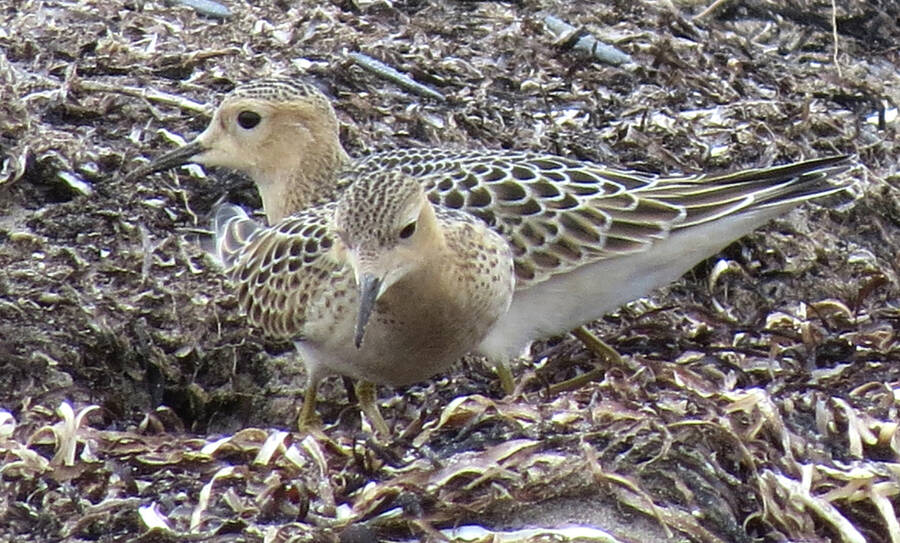
2023-09-13
The buff-breasted sandpiper
On Aug. 25 Logan Moore found two buff-breasted sandpipers at Sand Dollar Beach in Rose Bay. David Walmark and I made a trip there shortly afterwards and were pleased to get great looks at these birds.
The buff-breasted sandpiper nests in Alaska, the Yukon, Mackenzie, on the Melville Island, the Bathurst Island and south to King William Island. They winter in Argentina and migrate through the interior of Canada and the United States east of the Rocky Mountains.
In the fall, small numbers are found in Ontario, Quebec and south to New England and along the Gulf coast to Florida. They are casual in Siberia, the Kurile Island, Honshu, in British Columbia, Washington, California, Nebraska, Newfoundland, the West Indies and Venezuela.
The buff-breasted sandpiper is 18.75 to 21.25 cm. long with a wingspread of 41.25 cm. Both sexes are similar, but the male on average, is larger. They have all buff underparts including the tail and undertail coverts. There is a short bill, round head and long neck.
The bill is dark and there is a white eye-ring and dark feathers on the back edged with buff. The legs are pale yellow and the underwing linings flash silver-white in flight. The buff-breasted sandpiper eats mostly insects, beetles and their larvae and pupae of flies. They also eat spiders and some seeds of aquatic plants.
On Sept. 2, Lise Bell saw 20 plus northern gannets, sanderlings and loads of semi-palmated sandpipers and plovers at Crescent Beach. She also reported a few red-tailed hawks circling at Catidian Place.
On Sept. 3 I went on a pelagic trip out of Lunenburg along with 29 other birders. It was very quiet on the water in regards to seabirds. We had only herring gulls, great black-backed gulls, northern gannets, black guillemots, some common terns, ospreys, some bald eagles, double-crested cormorants, and the best bird, a lesser black-backed gull. Only a whole nine species of birds.
After returning to shore I took two birders from the valley around the area. We visited Shoreline Drive in Blue Rocks, the Silver Point Road in Garden Lots, the trail part of the Back Oler Farm Marsh, the Front Harbour Trail for Lunenburg, the Sawpit Park and First and Second Peninsula.
At the end of the day we had 53 species. Shorebirds included lesser yellowlegs, short-billed dowitchers, semi-palmated plovers, a sanderling and a greater yellowlegs. For warblers we found yellow-rumped, northern parula, common yellowthroat, black and white, and black-throated green. We had both red-eyed vireo and blue-headed vireo.
The largest number of species was found at the end of Second Peninsula, where we visited Glenn Rhodenizer. Glen told me about a late nesting pair of barn swallows that were still feeding young from their second nesting for the year.
He told us about his seeing the largest numbers of shorebirds that he has ever seen on the farm. He also reported a northern harrier and a common nighthawk on the road going out to the farm fields. We were also advised that bobolinks were still present.
Out of the birds that Glenn mentioned we saw barn swallows, a northern harrier and seven bobolinks. We were also pleased to find an American kestrel and an alder flycatcher.
The next day I made a trip to Kejimukjik National Park. In the park itself I found only two species of birds. On the way there and back only 15 species of birds were observed. However, there were goodly numbers of wood ducks in many of the ponds and lakes. On Aug. 27 Eric Mills observed four wood ducks at Steverman's Lake in Lilydale.
On Aug. 31, after visiting the Kejimukjik Seaside Adjunct, Logan Moore reported lots of shorebirds including two pectoral sandpipers and two American golden plovers. He also located a female blue-winged teal at the St. Catherines River.
On Sept. 2 a Baird's sandpiper was discovered at Cherry Hill Beach (Conrad's Beach) by Andrew Bates. Patricia Watson told me that the ruby-throated hummingbirds which were present at her place in East LaHave left on Aug. 30. They usually leave between Sept. 7 and the 15.
Elsewhere in Nova Scotia, on Aug. 31, a warbling vireo was seen at Sandy Cove by Diane LeBlanc. On Sept. 3, Richard Donaldson had two lark sparrows in Yarmouth. On that day, Bertin d'Entremont located a little blue heron at Bunker's Island in Yarmouth, Richard Stern had 11 red knots in the valley at the Guzzle, and Logan Moore found a stilt sandpiper at the West Long Island Road in Grand Pre.
A great discovery for Devin Johnson on Sept. 4 at Oak Island in Avonport was a blue-gray gnatcatcher. On Sept. 5 Mark Dennis located a warbling vireo and two prairie warblers at West Baccaro.
You may reach me at (902) 693-2174 or email me at jrhbirder@hotmail.com.






